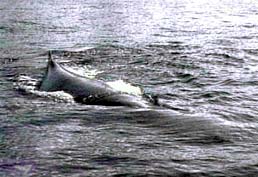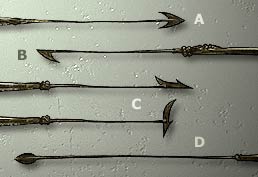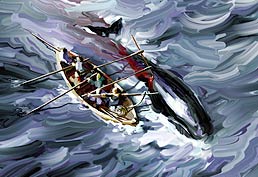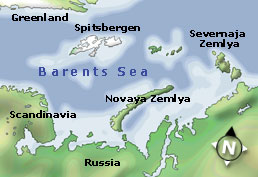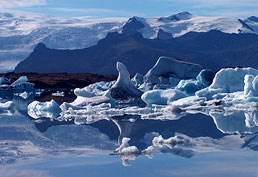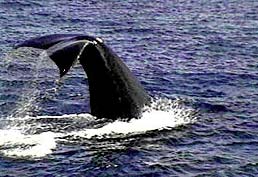|
|
|||||||||||||||||||||||||||||||||||||||||||||||||||||||||||||||||||||||||||||||||||||||||||||||||||||||||||||||
 |
|
||||||||||||||||||||||||||||||||||||||||||||||||||||||||||||||||||||||||||||||||||||||||||||||||||||||||||||||
|
It
is not known, when humans first started to hunt whales but countless
finds of the past leave no doubt that whaling already started thousands
of years ago, long before written records were kept. There is no archaeological evidence for all possible areas but we can assume that wherever people have lived, they have always found “use” for these exceptional mammals, as long as they could find a way to catch them. Due to the long and extensive history of whaling, it is impossible
to write an exhaustive documentation at this point. The information
on hand lays no claim to be comprehensive. It is at best a summary
of the historical key figures and focuses mainly on the developments
in Northwest-Europe. The American-European whaling business of the
14th century will therefore not be dealt with here (For the
reader interested in further reading, a look at the list of reference
books is recommended. Please see about whaling
› further reading). Whaling was not always related to harpoons, ropes and boats. Whales were captured in more primitive ways, before these ingenious fishing methods were established: poisoned arrows, fishing nets and the easiest method – to process beached animals or those that had strayed into shallow waters. It is easy to understand why the whale was a very popular catch, as every part of the animal could be used. The meat and blubber served as high energy food, the train-oil was suitable as fuel, the whalebone could be used as an elastic basic material for many products, and the bones as stable building material. Moreover, one single animal was able to supply huge quantities of these raw materials. The blue whale, the largest whale species, is a good example to
illustrate this point, even though the hunt for this huge animal
started relatively late: The inhabitants of Lapland were probably one of the first people in Europe to hunt whales on a larger scale – even before the Vikings. The period of the Vikings, the spreading of the Normans is dated to the 9th–11th century. Towards the end of this period the hunting for whales in Scandinavia and the North Sea region lost in significance, while new whaling centres formed in Southern Europe. The business flourished especially in the Spanish and French Basque region. Soon the French city of Bayonne, located at the bottom of the Pyrenees, became one of the most important trading centres for whale meat. The Spanish town of San Sebasián and other places have seen similar developments. The Bay of Biscay was a very rich fishing ground. In particular the North-Atlantic right whale (also known as the Biscayan right whale) migrated to spend the cold season in Biscay. But for these right whales it was much easier to swim into the bay than to get out: Continuously improved fishing techniques proved very successful for the Basques, resulting in a serious decimation of the whale population in Biscay at the beginning of the 11th century. This lead to reduced yields near the coast and the need to open up new distant fishing grounds. For this reason, in the mid 16th century Basque whalers crossed the Atlantic and began hunting near the North-American coastline. Around the same time their efforts expanded within Europe, in particular
into the North. At the beginning of the 17th century Basque
whalers were also present in the Westfjords of Iceland. Dutch voyages of discovery started the next important period in the history of European whaling. In the second half of the 16th century the southern sea passages to the Far East were subject to the supervision of Portugal and Spain. To escape their control, the English and Dutch seamen intensified the search for an alternative, northern route, the so-called “Northeast Passage”. While the search for a route through the Polar Sea was unsuccessful the Dutch explorers made another rewarding discovery: The polar waters around Spitsbergen were teeming with whales and walrusses. After the seamen were forced to spend the winter on Novaya Zemlya they brought the news of these rich fishing grounds to Europe on their return in 1597. Some years later, around 1611/1612, the first English and Dutch whalers appeared on the coasts of Spitsbergen and started the epoch of the so-called “Greenland Trade”. Although this name soon established itself, it was founded on a mistake: The Dutch explorer Willem Barents had mistakenly taken Spitsbergen for the East Coast of Greenland. The Region, in which “Greenland Traders” hunted their prey, reached from the European North Sea to the Greenland Sea up to the Barents Sea – from the Norwegian Jan Mayen to Spitsbergen. The probably most famous whaling station, which consisted of eight boiling stations was Smeerenburg on Amsterdamoya located on the north-western corner of Spitsbergen. For over 40 years mainly Dutch whalers, coopers, and men who boiled the train oil worked there – in busy times a few hundred men. As many whales stayed near the coast, in the bays, the demand could be fulfilled for some time by bay-fishing alone. But stocks were quickly depleted and therefore the work of catching and processing of whales had to be moved to the open sea. The era of ice- and sea fishing had begun. Far from the coast, methods for catching and processing whales had to be adapted to the changed conditions. Due to the large distance to the train oil boiling stations on land the blubber of the animals had to be stored in barrels and stored on board. The animals would be cut up in the water alongside the ship and “flensed” i.e. the blubber was cut off in pieces, hoisted in and the oil boiled out on board. The bowhead whale (balaena mysticetus) and the so-called North Atlantic right whale (eubalaena glacialis) were the most sought-after catches during the period of historical arctic whaling. Both species have features that make them a valued and relatively easy catch: Because of their large, stocky build they are slow swimmers (between five and ten kilometres per hour), they have an exceptionally thick layer of blubber, the largest baleen plates (up to four metres) and – most important – their carcasses float on the surface of the water. Especially this last feature gave the North Atlantic right whale it’s name “right whale”. This was of great importance as a dead but floating carcass could much easier be pulled ashore. With the advent of modern fishing techniques in the middle of the 19th century the hunt was extended to the faster Rorquals (Balaenopteridae) (see also about whaling › modern whaling › The Invention of the Harpoon Gun). The era of the “Greenland trade” lasted into the 20th century, more precisely until the start of the First World War. Therefore the epoch of European whaling lasted for almost exactly three centuries. Without question English and Dutch whalers set the tone during this time period. But the fleets of other nations had a considerable part in the events in the Polar sea: besides the French and Danish, also German ships of Hamburg or Altona ship owners – mostly manned by Friesians. The whaling business in Iceland had been under the control of foreign
countries for a long time. Norwegians founded the first whaling
station on the island in 1880. Soon companies from Germany, France
and other nations set up business there. The Icelanders themselves
did not run their own whaling station until 1930. The advance of harpoon guns and steam-powered ships changed not
only the technique of whaling, but it also considerably increased
the variety of animals that could be hunted. The combination of these technical innovations now enabled the whalers to harpoon whales that before were largely spared due to their speed: Rorquals like humpback whales, sei-, blue- and finback whales. Or doeglings. The hunt for doeglings plays only a secondary role in the history of whaling, but nevertheless, this 40-year period is of importance: Here the harpoon guns were first employed on a large scale to hunt whales. In the 1880s Norwegian and British seal hunters started to hunt doeglings (also called bottlenose- or beaked whales). Even though these animals did not constitute an important part of the catch during these hunting trips, they were still a welcomed addition to the seal catch. Pictures from this time clearly show, that doegling pods were hunted, using harpoon guns, firing directly from the bow of the mother ship or from rowing boats. Firing the harpoon gun from the mother ship has become the preferred method, as it is advantageous for the hunter and hasn’t changed significantly to our day.
Photos (from the top): IMSI Masterphotos, USA; Jens F. Ehrenreich (illustrations: harpoons, paintings and map);© pxcom/visipix.com; IMSI Masterphotos, USA |
||||||||||||||||||||||||||||||||||||||||||||||||||||||||||||||||||||||||||||||||||||||||||||||||||||||||||||||
